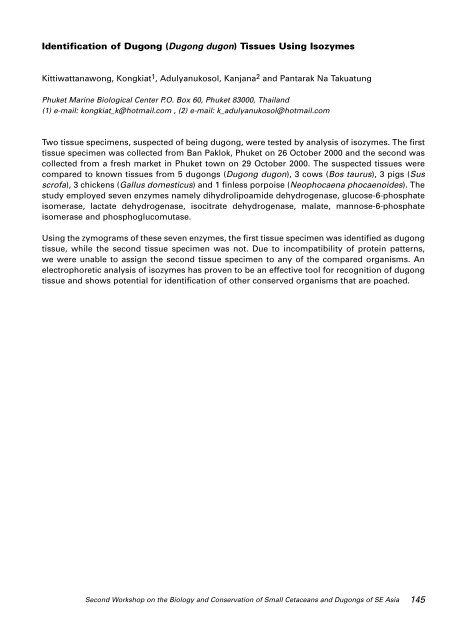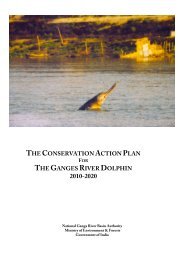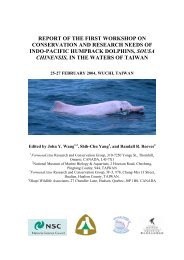Report of the Second Workshop on The Biology and Conservation of ...
Report of the Second Workshop on The Biology and Conservation of ...
Report of the Second Workshop on The Biology and Conservation of ...
Create successful ePaper yourself
Turn your PDF publications into a flip-book with our unique Google optimized e-Paper software.
Identificati<strong>on</strong> <str<strong>on</strong>g>of</str<strong>on</strong>g> Dug<strong>on</strong>g (Dug<strong>on</strong>g dug<strong>on</strong>) Tissues Using IsozymesKittiwattanaw<strong>on</strong>g, K<strong>on</strong>gkiat 1 , Adulyanukosol, Kanjana 2 <strong>and</strong> Pantarak Na TakuatungPhuket Marine Biological Center P.O. Box 60, Phuket 83000, Thail<strong>and</strong>(1) e-mail: k<strong>on</strong>gkiat_k@hotmail.com , (2) e-mail: k_adulyanukosol@hotmail.comTwo tissue specimens, suspected <str<strong>on</strong>g>of</str<strong>on</strong>g> being dug<strong>on</strong>g, were tested by analysis <str<strong>on</strong>g>of</str<strong>on</strong>g> isozymes. <strong>The</strong> firsttissue specimen was collected from Ban Paklok, Phuket <strong>on</strong> 26 October 2000 <strong>and</strong> <str<strong>on</strong>g>the</str<strong>on</strong>g> sec<strong>on</strong>d wascollected from a fresh market in Phuket town <strong>on</strong> 29 October 2000. <strong>The</strong> suspected tissues werecompared to known tissues from 5 dug<strong>on</strong>gs (Dug<strong>on</strong>g dug<strong>on</strong>), 3 cows (Bos taurus), 3 pigs (Susscr<str<strong>on</strong>g>of</str<strong>on</strong>g>a), 3 chickens (Gallus domesticus) <strong>and</strong> 1 finless porpoise (Neophocaena phocaenoides). <strong>The</strong>study employed seven enzymes namely dihydrolipoamide dehydrogenase, glucose-6-phosphateisomerase, lactate dehydrogenase, isocitrate dehydrogenase, malate, mannose-6-phosphateisomerase <strong>and</strong> phosphoglucomutase.Using <str<strong>on</strong>g>the</str<strong>on</strong>g> zymograms <str<strong>on</strong>g>of</str<strong>on</strong>g> <str<strong>on</strong>g>the</str<strong>on</strong>g>se seven enzymes, <str<strong>on</strong>g>the</str<strong>on</strong>g> first tissue specimen was identified as dug<strong>on</strong>gtissue, while <str<strong>on</strong>g>the</str<strong>on</strong>g> sec<strong>on</strong>d tissue specimen was not. Due to incompatibility <str<strong>on</strong>g>of</str<strong>on</strong>g> protein patterns,we were unable to assign <str<strong>on</strong>g>the</str<strong>on</strong>g> sec<strong>on</strong>d tissue specimen to any <str<strong>on</strong>g>of</str<strong>on</strong>g> <str<strong>on</strong>g>the</str<strong>on</strong>g> compared organisms. Anelectrophoretic analysis <str<strong>on</strong>g>of</str<strong>on</strong>g> isozymes has proven to be an effective tool for recogniti<strong>on</strong> <str<strong>on</strong>g>of</str<strong>on</strong>g> dug<strong>on</strong>gtissue <strong>and</strong> shows potential for identificati<strong>on</strong> <str<strong>on</strong>g>of</str<strong>on</strong>g> o<str<strong>on</strong>g>the</str<strong>on</strong>g>r c<strong>on</strong>served organisms that are poached.<str<strong>on</strong>g>Sec<strong>on</strong>d</str<strong>on</strong>g> <str<strong>on</strong>g>Workshop</str<strong>on</strong>g> <strong>on</strong> <str<strong>on</strong>g>the</str<strong>on</strong>g> <strong>Biology</strong> <strong>and</strong> C<strong>on</strong>servati<strong>on</strong> <str<strong>on</strong>g>of</str<strong>on</strong>g> Small Cetaceans <strong>and</strong> Dug<strong>on</strong>gs <str<strong>on</strong>g>of</str<strong>on</strong>g> SE Asia 145





